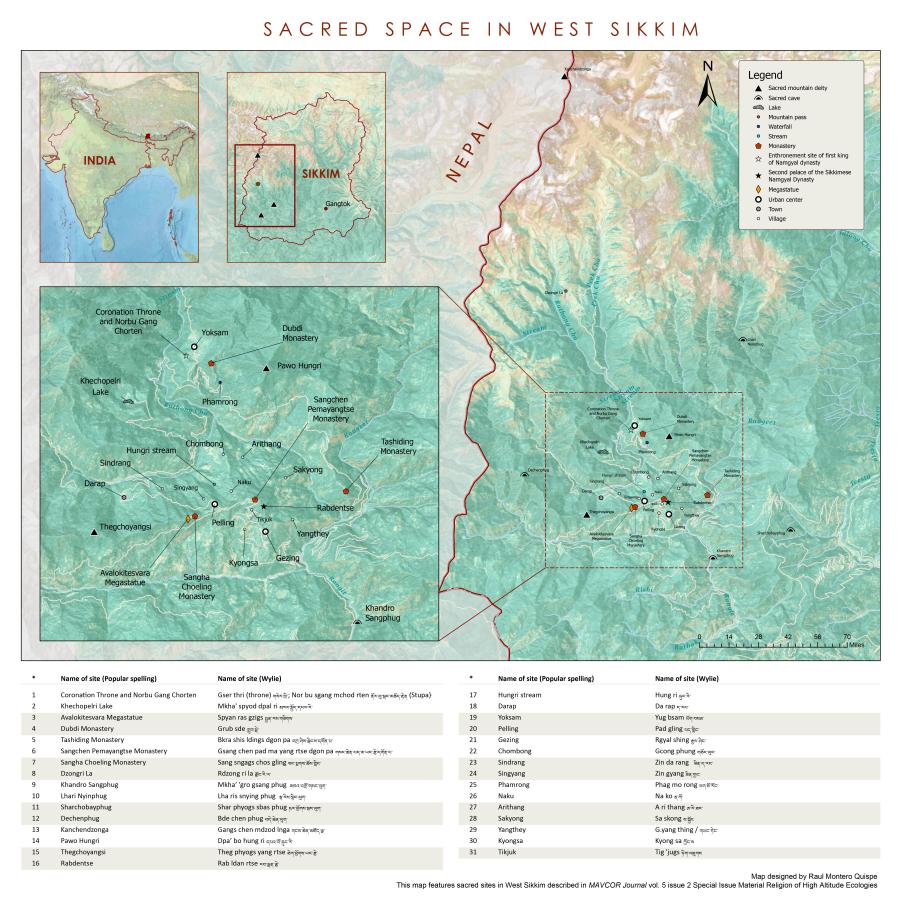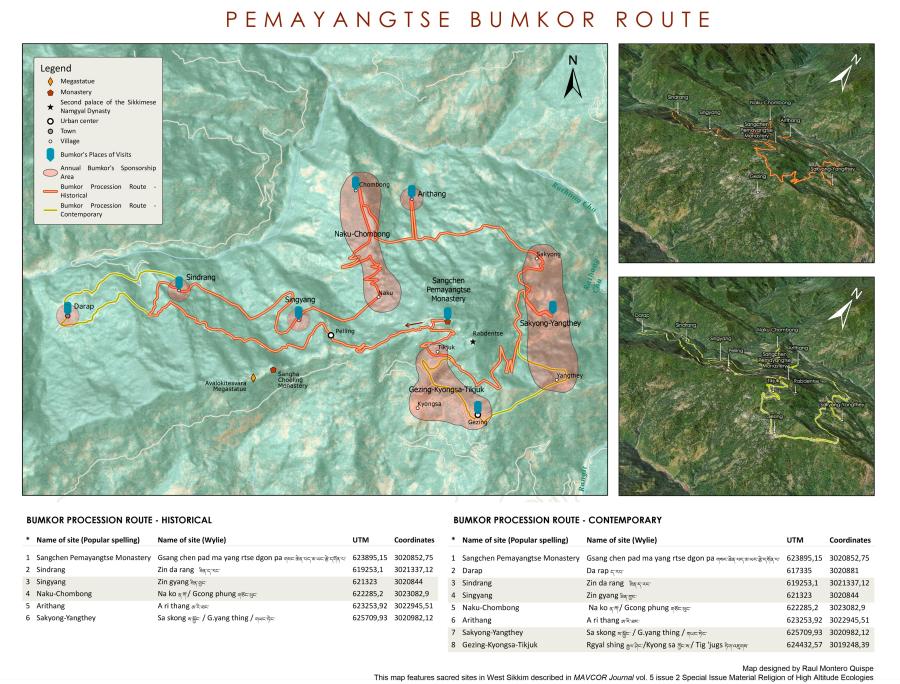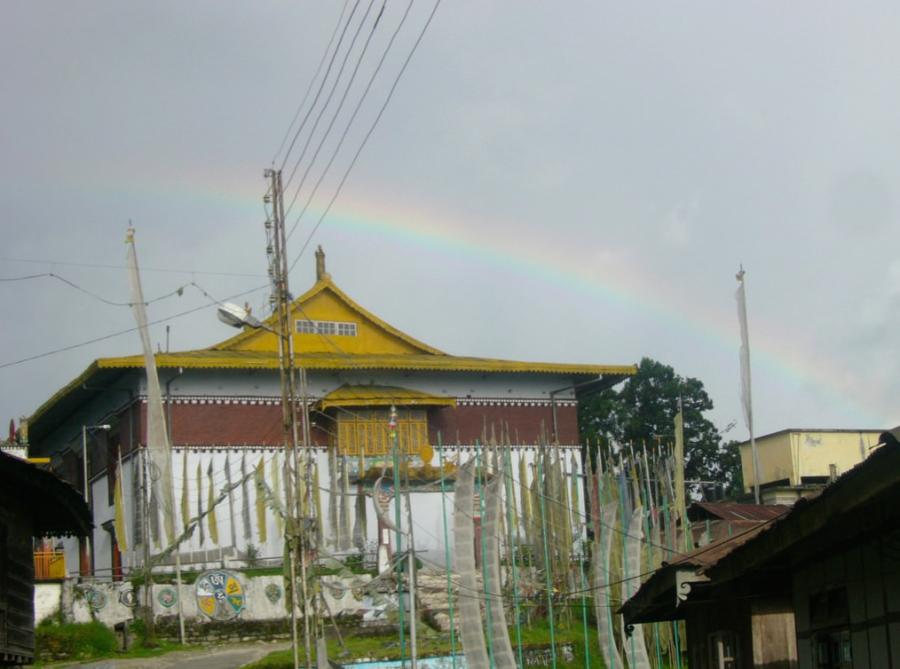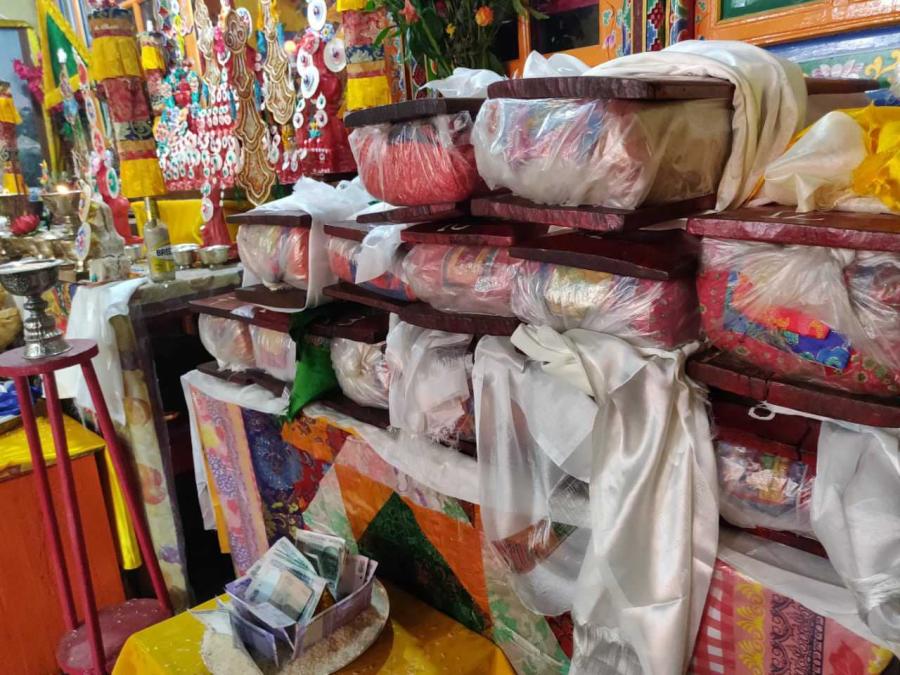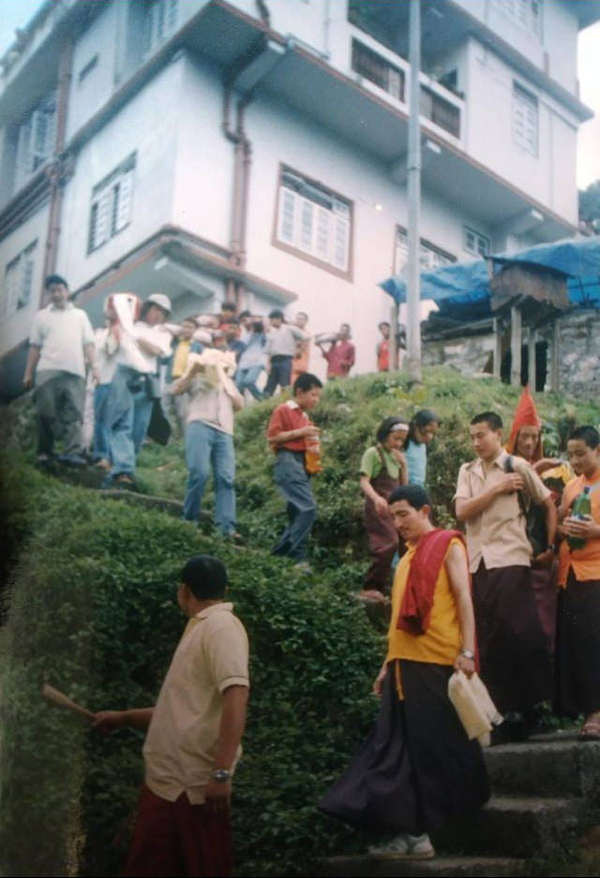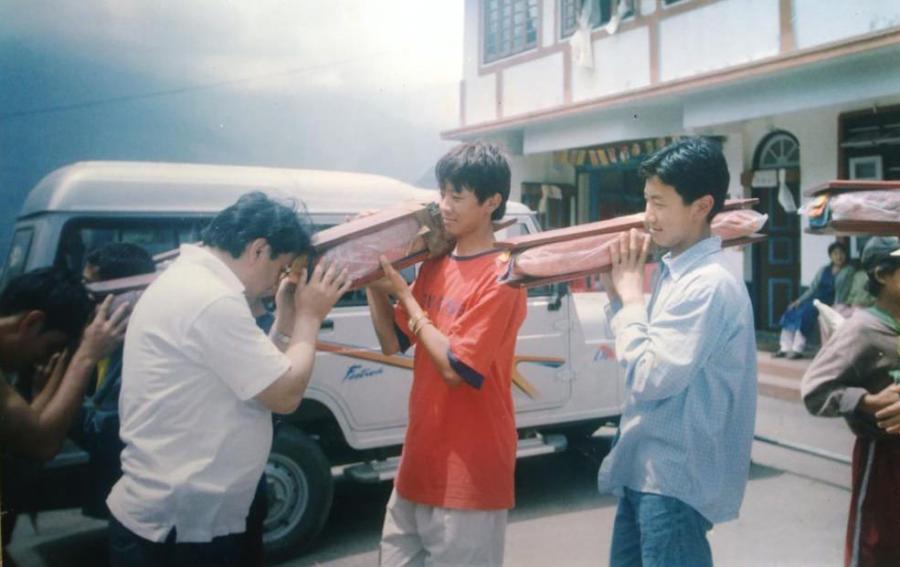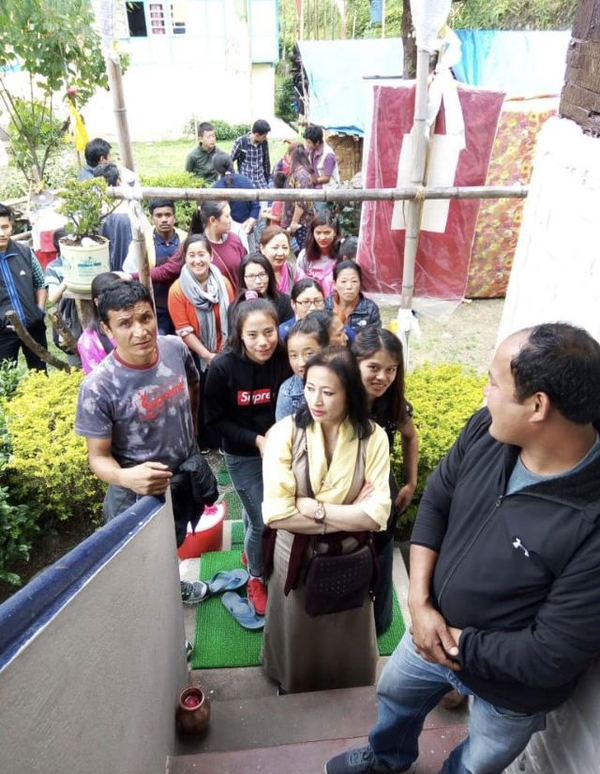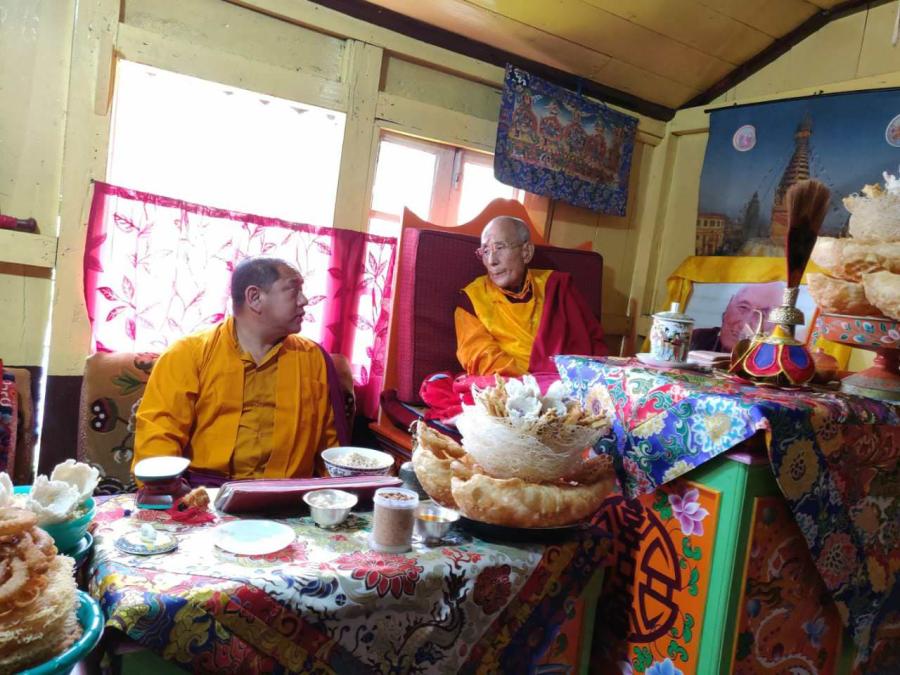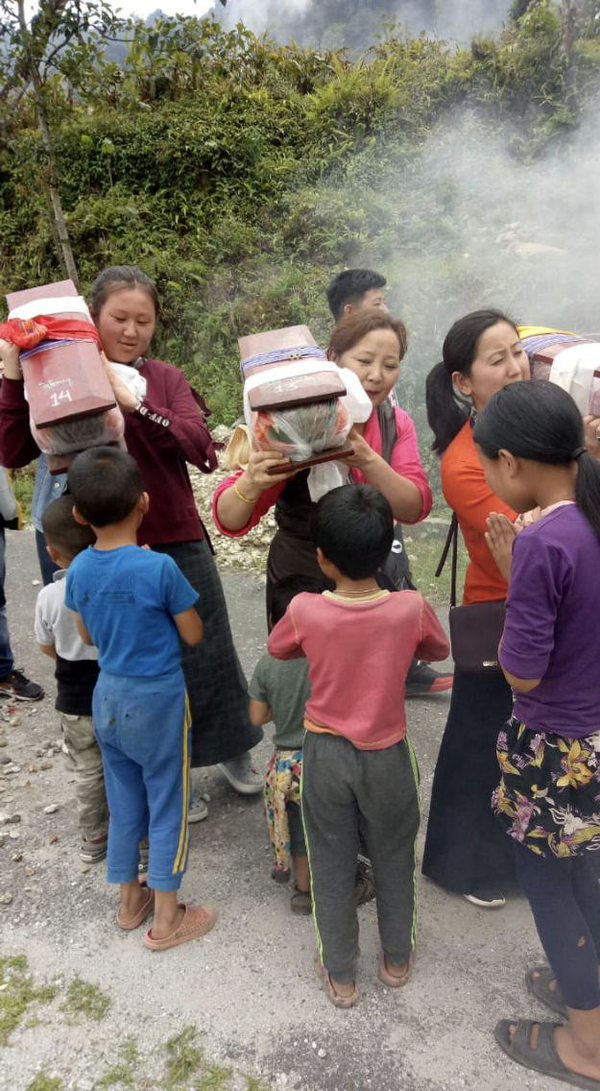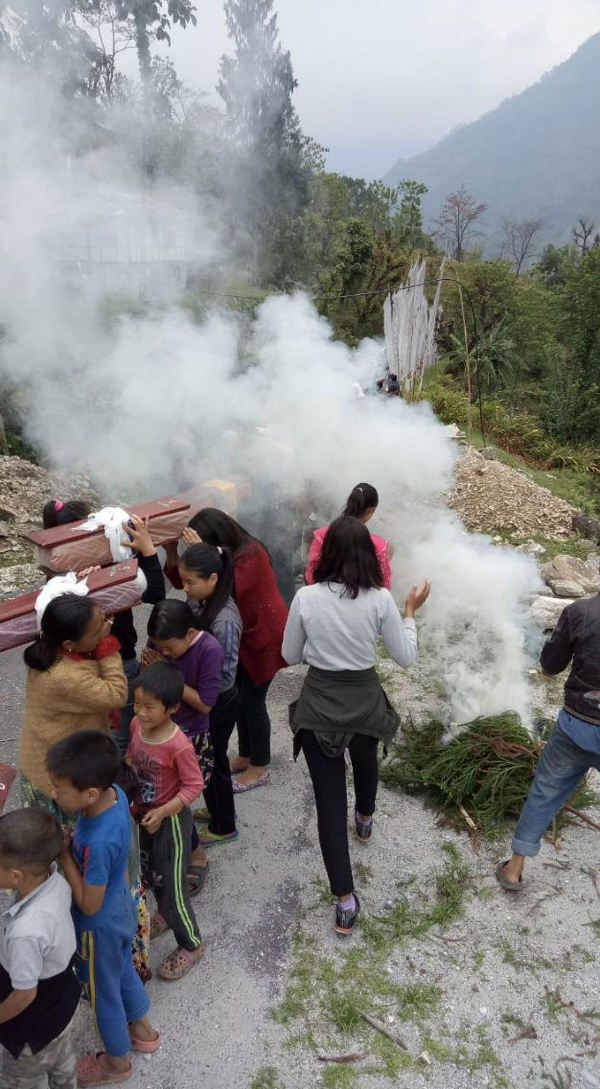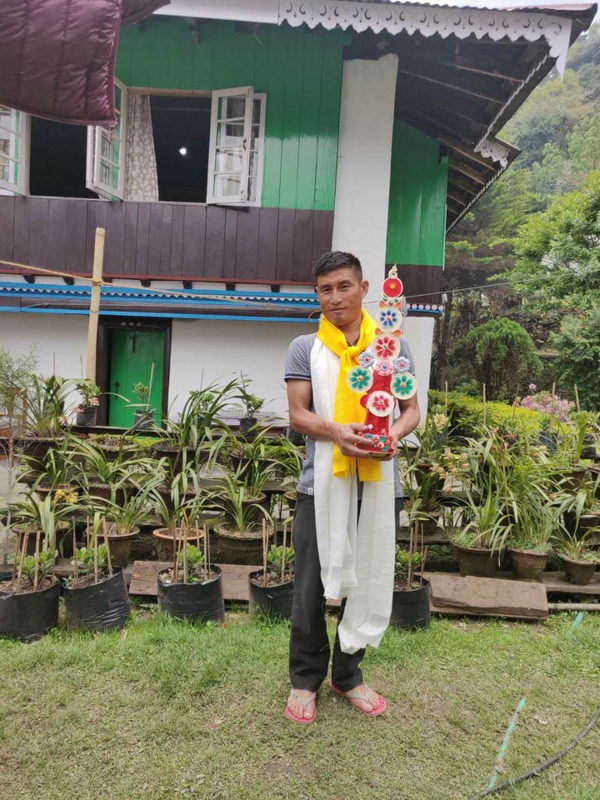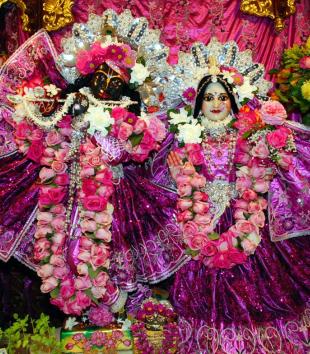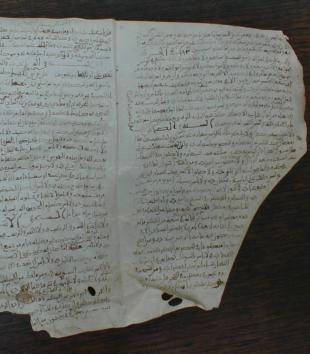Dr. Amy Holmes-Tagchungdarpa (she/her/hers) is an associate professor in the Department of Religious Studies at Occidental College in Los Angeles, CA, the United States and a Senior Fellow in the Society of Fellows in Critical Bibliography at the Rare Book School. She is the author of The Social Life of Tibetan Biography: Textuality, Community, and Authority in the Lineage of Tokden Shakya Shri (Lanham, MD: Lexington Books, 2014), and is currently working on a study of Himalayan Buddhist material culture and ecological change.
Introduction
In the shadow of Mount Kanchendzonga (Tibetan: Gangs chen mdzod lnga),1 as the winter gave way to spring and the frost thawed into warm, sunny days, the local Buddhist community that lived in the villages around Pemayangtse Monastery (Tibetan: Pad ma yang brtse dgon pa) in western Sikkim prepared for special visitors. Down the ridge from Pemayangtse, residents of the fifty-three households that made up the village of Sindrang (Bhutia: Zin da rang)2 in 2007 changed into their best clothes and congregated around the home of Yab Sonam Wangchuck and his wife Chum Pema Lhanjee. Members of Yab Sonam and Chum Pema’s household had been cleaning and preparing for this day for several weeks, making maize snacks such as byasu and kyabze and cleaning out the household shrine (Tibetan: mchod bsham). A group made up of representatives from each of the households in the village donned their best clothes and gathered in the courtyard outside, readying silk offering scarves (Tibetan: kha bdags) for their guests. Early in the morning, they began their walk up to Pemayangtse. Residents of villages on the way, including Singyang (Bhutia: Zin g.yang), Chombong (Bhutia: Gcong phung), and Pelling (Bhutia: Pad gling) made smoky offerings of tree branches and other aromatic substances (Tibetan: bsang)3 outside of their homes to purify the path. Other Sindrang residents who remained behind busied themselves burning smoky offerings and assisting Yab Sonam Wangchuck’s family with cooking.
The special guests that the community prepared to welcome were not lamas (Tibetan: bla ma), tulkus (Tibetan: sprul sku), or other exalted members of the Buddhist community in a conventional, human sense. They were, in fact, books: a selection of fourteen to seventeen volumes from the classical Tibetan language Buddhist canon, known as the Kangyur (Tibetan: bka’ ’gyur) that were carried by villagers in a procession from the monastery down to the village, and then around the fields, before moving on to the next village.4 This selection of books is known throughout Tibetan and Himalayan cultural areas as Bum (Tibetan: ’Bum), and represents a distillation of the literature of The Perfection of Wisdom (Tibetan: Shes rab kyi pha rol tu phyin pa; Sanskrit: Prajñāpāramitā Sūtra).5
- 1This essay will discuss examples from across a number of Tibetan and Himalayan Buddhist communities. These communities are united in their use of classical Tibetan language for their texts; however, they also use local languages that may not have any linguistic connection to classical Tibetan. Sikkim, the primary site I will discuss here, is a multilingual and multiethnic state in northeast India. In this essay, I will discuss a case study from west Sikkim based on interviews and observations from Sindrang village, where the inhabitants are mostly from Lepcha and Bhutia ethnic groups, and I use these terms as they are the most commonly used terms for these ethnic groups in contemporary Sikkim. My observation of the Bumkor was undertaken in a household where the primary language spoken was Bhutia. Due to this, in this essay, non-English terms in Tibetan and Bhutia (also known as Lhokyed, the language used by the Bhutia, or Lhopo, community in Sikkim) will be given in phonetic form based on pronunciation of terms in west Sikkim (for example, I have used Kangyur for bka’ ’gyur, instead of Kagyur or Kanjur). Upon their first appearance, they will be followed by full transliteration into their classical Tibetan form using the popular Wylie transliteration system. Spelling in quotations has been modified accordingly.
- 2Sindrang is a village in west Sikkim near Pelling. The 2011 census listed 54 households; according to the village panchayat (the local elected village representative), in 2007 the amount was roughly the same. https://www.census2011.co.in/data/village/260996-sindrang-sikkim.html [Accessed December 15, 2020].
- 3See Kalzang Dorjee Bhutia’s article in this issue for more on smoky offerings. Kalzang Dorjee Bhutia, “Purifying Multispecies Relations in the Valley of Abundance: The Riwo Sangchö Ritual as Environmental History and Ethics in Sikkim,” MAVCOR Journal 5, no. 2 (2021).
- 4In this article, I use the word “books” to refer to pecha, loose-leaf pages that are most commonly not bound. Historically, pecha contained classical Tibetan language and the term does not specify whether the texts within are handwritten, woodblock- or laser-printed. For more on book cultures in Tibet and the Himalayas, see Mark Elliot, Hildegard Diemberger, and Michela Clemente, eds., Buddha’s Word: The Life of Books in Tibet and Beyond (Cambridge: Museum of Archaeology and Anthropology, University of Cambridge, 2014) and Hildegard Diemberger, Franz-Karl Ehrhard and Peter Kornicki, eds., Tibetan Printing: Comparison, Continuities, and Change (Leiden: Brill, 2016).
- 5Forms of Vajrayāna, or Tantric, Buddhism are practiced on the Tibetan plateau and throughout the Himalayas and inner Asia in areas of a number of contemporary nation states, including China, India, Nepal, Bhutan, Mongolia, and Russia. While historically these forms have been labeled as “Indo-Tibetan” or “Tibetan” Buddhism, these categorizations do not capture the complexities of these forms or the diverse identities that Buddhist practitioners in this region are affiliated with. Some of these forms of identity are national—for example, Bhutanese people do not consider themselves Tibetan, and Bhutan is home to a number of distinctive Buddhist traditions. What does unite these traditions with each other, and with other Buddhist communities in the Himalayas, is the use of classical Tibetan as the language of their textual traditions, and elements of shared history, including lineage affiliation and ritual tradition. This leads these forms of Buddhism to be distinct from other forms of Buddhism found in the region, specifically Newar Buddhism and Theravāda Buddhism. As this is a comparative paper, I will refer to the Buddhist traditions under discussion as “Tibetan and Himalayan Buddhism” or by specific geographical labels.
The Perfection of Wisdom is a collection of texts that date back to the development of early Mahāyāna Buddhism in India. The Sanskrit texts that formed the basis for the Tibetan translations appeared to have assumed their basic format between the first century BCE and the seventh century CE.1 The Perfection of Wisdom texts contain within them the core ideal of Mahāyāna Buddhism, emptiness (Tibetan: stong pa nyid; Sanskrit: śūnyatā). In the Heart Sūtra, a text that condenses the ideals of the Perfection of Wisdom series, the Buddha outlines how practitioners should be “trained” to perceive all of reality as “empty of inherent existence.” As the Sūtra famously states, “Form is emptiness; emptiness is form. Emptiness is not other than form; form is not other than emptiness. In the same way, feeling, discrimination, compositional factors, and consciousness are empty.”2 In Tibetan and Himalayan communities, this Sūtra is exalted as it is held to represent “the final wisdom [of the Buddha], directly realizing all the modes and varieties of phenomena in a single instant.”3
- 1Fabrizio Torricelli and Nickolai N. Dudka, “Manuscript LTWA No. 23476: A ‘sDe can’ Sample of the brGyad stong pa,” The Tibet Journal 24, no. 2 (1999): 29.
- 2Translation from Donald Lopez, The Heart Sutra Explained: Indian and Tibetan Commentaries (Albany: State University of New York Press, 1988), 19.
- 3Ibid., 23.
In Tibetan and Himalayan Buddhist communities, the Perfection of Wisdom developed different iterations:
- The Perfection of Wisdom in 100,000 Lines (Tibetan: Shes rab kyi pha rol tu phyin pa stong phrag brgya pa; Sanskrit: Śatasāhasrikāprajñāpāramitā), or in short, the Bum (Tibetan: ’Bum), which makes up around 12 volumes (depending on the printed or manuscript edition of the text);
- The Perfection of Wisdom in 25,000 Lines (Tibetan: Shes phyin stong phrag nyi shu lnga pa; Sanskrit: Pañcaviṃśatisāhasrikā Prajñāpāramitā), or in short Nyithi (Tibetan: Nyi khri) which makes up around three volumes (depending on the printed or manuscript edition of the text);
- The Perfection of Wisdom in 8,000 Lines (Tibetan: Sher phyin brgyad stong pa; Sanskrit: Aṣṭasāhasrikāprajñāpāramitā), on in short, Gyadtongpa (Tibetan: Brgyad stong pa), which makes up around one volume (depending on the printed or manuscript edition of the text).1
- 1L.A. Waddell’s classic colonial study of Buddhism discusses what parts of the canon are included in the Bum:
The first twelve volumes [of the Kangyur], called ’Bum (Skt. Ṣata Sahasrikā) or “the 100,000 (slokas of Transcendental Wisdom),” treat fully of the Prajñā-pāramitā at large, and the remaining volumes are merely various abridgements of these twelve. Thus the three volumes called Ñi-k’ri (pron. Nyi-thi) or the “20,000 (slokas)” is intended for those monasteries or individuals who cannot purchase or peruse the full text… - L.A. Waddell, The Buddhism of Tibet, or Lamaism (London: W.H. Allen & Co., Limited, 1895), 161.
I retain his description here for his mention of affordability, as this demonstrates an interesting consideration of economic materiality. Buddhologist Edward Conze published extensively on Perfection of Wisdom literature. See, for example, Edward Conze, The Prajñāpāramitā Literature (‘S-Gravenhage: Mouton, 1960).
The H. E. Sindrang Yab Gomchen, the Dorje Lopen (Vajra Master) of Pemayangtse Monastery, Chewang Rinzin, was born in Sindrang, raised his family there, and hosted the Bumkor many times (his son Yab Sonam Wangchuck is carrying on the tradition). According to him, these texts were distilled in different versions in order to represent the Mahāyāna ideal of skillful means (Tibetan: thabs; Sanskrit: upāya). The development of these different lengths and formats acknowledged that since all sentient beings have different karmic propensities and experiences, they needed access to different teachings and iterations of conventional and ultimate reality suited to their own dispositions in order to access the ultimate Buddhist goal of enlightenment. Sindrang Yab Gomchen Pemayangtse Dorje Lopen Chewang Rinzin told me that the Bum had special significance since it distilled The Perfection of Wisdom, the Mother of the Buddhas, due to its synthesis of the highest truth of emptiness; these books are the same as the voice of the Buddha.1
This invocation of Mahāyāna ideals provided further constructive interpretive scaffolding for understanding the significance of the Bum. On a conventional level, or to extend the language of the Perfection of Wisdom, on the level of form, the Bum were books, or pecha (Tibetan: dpe cha), and were therefore inanimate objects that contained the printed words of the Buddhist teachings. But these books also had other levels that acknowledged their power as apotropaic, healing agents, and in an ultimate sense, they were understood to be embodiments of the Buddha and capable of generating blessings and merit; in this way, they are representative of the truth of emptiness.2 Art historical research has demonstrated how the materiality of book editions and other material culture such as statues has been used historically for pedagogical reasons, as both their contents and material forms were seen to be capable to generating the blessings of the Perfection of Wisdom.3 In this article, I am interested not only in the materiality of these books, but also what people do with them. In western Sikkim, when they are wrapped in offering scarves, taken to visit the homes of local Buddhist patrons, and carried around local villages and fields as part of a ritual procession, or circumambulation, known as the Bumkor (Tibetan: ’bum skor or bum skor), the books that make up the Bum are not just objects, but are generative, active agents that are capable of producing and renewing auspiciousness in the local human and nonhuman community that resided in the landscape.
This community in the west district of Sikkim is one of many communities with similar ritual visits hosted throughout Tibet and the Himalayas during the annual ritual calendar. At times, the entire Kangyur canon (which can be over one hundred volumes in length, depending on the edition) is taken out and carried around villages as well in a ritual known as the Kangyur kora (Tibetan: bka’ ’gyur skor ba). In this paper, I will discuss the Sindrang Bumkor as an example of a distinctive Tibetan and Himalayan ethnography of the book that acknowledges the active lives books have in human societies beyond their textual content that at the same time reflects or enacts that content.4 Buddhist Studies as a field has tended to emphasize the study of texts without considering their materiality, or what Buddhists do with these books, and how these functions may represent different forms of pedagogy for different audiences. In this paper, I will explore material interactions between people and books, and books’ generative potential based on forms of efficacy associated with The Perfection of Wisdom and other books in Buddhist societies. These forms of efficacy include the power to heal, purify, protect, and nourish. Although the Bumkor does not include a complete reading of the Bum (aside from a few pages in order to create positive connections [Tibetan: rten ’brel] with the community), the enactment of the Bumkor in west Sikkim provides an example of how a community-organized ritual allows for the enactment of central ideas from The Perfection of Wisdom. This ritual tradition represents an actualization of the idea of skillful means by demonstrating how Buddhist books may inspire and inform communities using methods beyond textual study by becoming valued community members themselves and the understudied connections between the content of books and their social roles.
In my discussion, I will draw on the scholarship of anthropologists Alfred Gell on the agency of objects, Hildegard Diemberger on Tibetan and Himalayan book culture, Geoff Childs, who studied the Kangyur Kora in Nubri in the Gurkha region of Nepal, and Kim Gutschow and Niels Gutschow who studied a Bumkor in Rinam in Zangskar in northwest India, to put these studies in conversation with my own observations of the Bumkor in western Sikkim in northeast India. To unpack the powers generated by the books that make up the Bum, I will discuss comparative elements of book circumambulation processions drawing on case studies from other scholars alongside my own observation of, and participation in, Bumkor traditions in west Sikkim on several occasions between 2007 and 2018.
- 1Sindrang Yab Gomchen Pemayangtse Dorje Lopen Chewang Rinzin, interview, July 2019. The significance of the Bum as a distillation of the Buddha’s teachings can also be seen from the foundational role of this set of texts in the establishment of a household shrine. If possible, Sikkimese Buddhist families will aim to have at least this set of texts as representations of the Buddha’s speech (Tibetan: gsung) in their shrine room. I will expand on the position of books in household rituals in future publications.
- 2My thanks to one of the anonymous reviewers for this thoughtful insight.
- 3Art historical works on Perfection of Wisdom-related materials include Jinah Kim, Receptacle of the Sacred: Illustrated Manuscripts and the Buddhist Book Cult in South Asia (Berkeley: University of California Press, 2013); Petra Müller, “Representing Prajñāpāramitā in Tibet and the Indian Himalayas: The iconographic concept in the Temples of Nako, rKyang bu and Zha lu,” in The Arts of Tibetan Painting: Recent Research on Manuscripts, Murals and Thangkas of Tibet, the Himalayas and Mongolia (11th–19th century), Asian Art ed. Amy Heller (2011), https://www.asianart.com/articles/mueller/index.html [Accessed December 15, 2020]; Reed O’Mara, “‘On Golden Tablets’: The Cleveland Museum of Art’s Aṣṭasāhasrikā Prajñāpāramitā Manuscript as a Self-Referential Icon,” Religions 11, no. 274 (2020): 1-19.
- 4There are many communities that practice versions of this ritual, but surprisingly few studies dedicated to it, and none that I could locate that focused on its significance for understanding ethnographic functions of books with the exception of Cathy Cantwell, who mentions it briefly in her article “Seeing, Touching, Holding, and Swallowing Tibetan Buddhist Texts,” Postscripts 8, nos. 1-2 (2017): 147, citing examples seen by anthropologist Lawrence Epstein in Mysore in 1966, Martin Mills in Lingshed, Ladakh, and Geoff Childs (which will be discussed below). Other localities that practice versions of this tradition that have been studied include Kag in Southern Mustang, Nepal (discussed in Charles Ramble, “Patterns of Places,” in Reflections of the Mountain: Essays on the History and Social Meaning of the Mountain Cult in Tibet and the Himalaya, eds. Anne Marie Blondeau and Ernst Steinkeller (Vienna: Verlag de Österrichschen Akademie der Wissenschaft, 1996), 141-153); and among Monguors in Gansu (studied in Louis M.J. Schram, “The Monguors of the Kansu-Tibetan Border: Part II. Their Religious Life,” Transactions of the American Philosophical Society 47, no. 1 (1957): 100-101). A fascinating historical description from Darjeeling has been published as Jivanji Jamshedji Modi, “A Book-Procession of the Tibetan Llamas, as Seen at Darjeeling,” Anthropological Papers Part IV: Papers Read Before the Anthropological Society of Bombay (Bombay: British India Press, 1929), 93-99.
Sikkim is an eastern Himalayan state that borders Nepal, China, Bhutan, and the Indian state of West Bengal. Sikkim is now a multiethnic and multireligious state that is part of India. Before 1975, when the state became part of India, it was an independent kingdom nominally presided over by a Buddhist king (Tibetan: chos rgyal). The history of the state has been historically intertwined with Tibetan-derived Buddhist prophecies as a having a special status as a safe haven or “Hidden Land” (Tibetan: sbas yul), set apart by the popular promulgator of Buddhism in Tibet, Guru Rinpoche.1 Therefore, even though it is not the demographically dominant religion of the state, Buddhism continues to occupy an important position in daily life among many different ethnic groups and along with the other religions present in Sikkim constitutes an important part of Sikkim’s diverse shared heritage. While there are a number of Bumkor traditions in Sikkim,2 I researched and participated in the event that takes place around Pemayangtse Monastery, the royal monastery, in west Sikkim.3 In this annual event that takes place on the fifteenth day of the second month of the lunar calendar (normally in March or April), seven of the eleven villages that were historically administered by the monastery and paid taxes to it take turns hosting the Bum for one night each during the harvesting of barley, buckwheat and other crops that takes place following the winter.4 When I discuss the ritual below, I will summarize events from this eleven-year period based on my own observations and interviews with Bumkor participants, with additional details provided in instances of important changes or deviations during specific years.
- 1For more on Sikkimese history and culture, see anthropologists Anna Balikci’s Lamas, Shamans and Ancestors: Village Religion in Sikkim (Leiden: Brill, 2008); Vibha Arora’s “Roots and the Route of Secularism in Sikkim,” Economic and Political Weekly 41, no. 38 (2006), and Charisma Lepcha’s “Religion, Culture, and Identity: A Comparative Study on the Lepchas of Dzongu, Kalimpong, and Ilam,” Unpublished Ph.D. dissertation, North-Eastern Hill University, 2013; historian Saul Mullard’s Opening the Hidden Land (Leiden: Brill, 2011); geographers Mona Chettri’s Ethnicity and Democracy in the Eastern Himalayan Borderland (Amsterdam: University of Amsterdam Press, 2017) and Mabel Gergan’s “Living with Earthquakes and Angry Deities at the Himalayan Borderlands,” Annals of the American Association of Geographers 107, no. 2 (2017): 490-498. For specific discussion of Buddhism in west Sikkim, see Kalzang Dorjee Bhutia, “Foxes, Yetis and Bulls as Lamas: Human-Animal Interactions as a Resource for Exploring Buddhist Ethics in Sikkim,” Journal of Buddhist Ethics 25 (2018): 45-69 and “Purifying Multispecies Relations in the Valley of Abundance,” MAVCOR Journal 5, no. 2 (2021).
- 2In Sikkim, this is an understudied but common ritual event. Anna Balikci has studied the Bumkor in Sikkimese village of Tingchim in her comprehensive anthropological study, Lamas, Shamans and Ancestors, 59; and more recently, Charisma Lepcha discusses it in relation to ecological change in “Lepcha Water View and Climate Change in Sikkim Himalaya,” in Environmental Humanities in the New Himalayas, eds. Dan Smyer Yü and Erik de Maaker (New York: Routledge, forthcoming).
- 3This Bumkor is briefly described in Hissey Wongchuk Bhutia’s informative history of a temple in west Sikkim, “A Precious Ocean of Amazing Faith: The History and Practices of Chumpong Mani Lhakhang (Temple),” Bulletin of Tibetology 47, nos. 1 & 2 (2011): 74-75.
- 4My deep gratitude to the people of Sindrang for inviting me to participate in the Bumkor and sharing their experiences with me.
Books as Agents
Sikkim is home to a variety of ritual traditions that involve the recitation of texts. The Bumkor is particularly noteworthy because it is focused on the propitiation of books as venerated guests and community members. This treatment of books is by no means unique to Tibet and the Himalayas, and is found throughout South Asia and the Buddhist world. Since a very early period in Mahāyāna Buddhist history, “the cult of the book” has been an influential part of ritual life in Buddhist communities, where owning, seeing, copying, reading, and hearing were all recommended as forms of interaction that would create opportunities for generating merit. Multiple canonical texts, including the Lotus Sūtra, the Diamond Sūtra, and the Flower Adornment Sūtra extolled the virtues of worshipping books, which included giving them offerings as well as engaging in copying and reading.1 Historian Gregory Schopen has discussed the use of books as protective talismans in South Asian domestic settings in the early first millennium CE,2 and as Buddhism spread to China and other areas, so too did beliefs associated with the power of the book.3 As art historian Jinah Kim writes, the book has not just served as “a symbol of knowledge and authority but also a central object of worship, often serving as a great vehicle for the achievement of . . . ritual means.”4 In her important book Receptacle of the Sacred, Kim analyzes medieval Tantric books from South Asia, emphasizing that studying their layout and iconography as well as their textual contents reveal them to not only have been objects of reverence, but also ritual agents.
In modern Nepal, books retain this power. In David Gellner’s study of the readings of the Perfection of Wisdom at Kwa Bahah temple in Lalitpur, sponsors who provided patronage for the text to be read by ritual specialists mentioned a variety of motivations and occasions that led them to do so. These included illness, an auspicious occasion (such as a new house), a major life event in the family such as death, employment issues and aspirations, “the hope of safe return” from travel, or the general aspiration for clearing “ill fortune or bad luck in the home.”5 During a time of crisis, such as illness, sponsors made vows to deities that in exchange for healing or the clearance of an obstacle, they would sponsor the reading of the text.6 These reasons were given alongside more conventionally Buddhist reasoning that people gave for this sponsorship that included the desire to do good work, bring peace to one’s family and one’s mind, prevent obstacles or dangers, show devotion, or “uplift beings or the world.”7 These reasons demonstrate the belief that books as objects, as well as the knowledge within them, could bring about change and human flourishing.
Other South Asian religious communities also venerate their texts directly as community members. In Sikh communities, the central text of the community, the Gurū Granth Sāhib does not just symbolize or signify the teachings of their human gurus. As religious studies scholar Kristina Myrvold writes, the Gurū Granth Sāhib
. . . is an object of worship because the text is the guru as a person invested with agency to mediate a spiritual teaching and minimize the ontological gap between humans and the divine. In the daily liturgy of the gurdwārā, the physical manifestation of the text in a book form is treated like worldly royalty granting an audience: the Sikhs present the scripture with prayers, food, clothes, and offerings to be blessed; they put it to sleep in a human bed at night; and they recite and listen to its worlds as if a living guru continued to give verbal instructions.8
Along with this physical treatment and veneration, the Gurū Granth Sāhib has also received recognition for its authority beyond the Sikh community in the Indian nation state. In 2000 the Supreme Court of India declared that the Gurū Granth Sāhib a “juristic person” capable of holding and using property presented to the community as a form of charity.9
Traditions around Buddhist books in Tibet inherited much from their South Asian predecessors. In South Asia, books (Sanskrit: pustaka) were produced from treated palm leaves, and were long in form, as determined by the shape of the palm leaves used, and tied through the middle instead of being bound at the side. Veneration of The Perfection of Wisdom texts dates back to early Mahāyāna Buddhism and was especially associated with the “Cult of the Book” due to the equation of the text and its reader with the Buddha.10 Palm leaves were not available in the high Himalayas, but Tibetan books still resembled South Asian books in form: produced from loose leaf, unbound paper made from different roots and trees, they were long, unbound and even referred to as pothi (Tibetan: po ti), a term clearly derived from the term pothi used for book in a number of north Indian languages. Similar to the South Asian context, books in Tibet and the Himalayas were seen as living members of the Buddhist community, as physical “supports” capable of generating and conferring the blessings of the Buddha’s speech (Tibetan: gsung rten) that they contain. In Tibetan and Himalayan areas, this phenomenon manifested in a number of ways, including extending the rules of etiquette related to honorable members of the religious community to books: not putting them on the floor or in low places, wrapping them appropriately in valuable fabric, and importantly, seeing them as capable of conferring blessings, as demonstrated by the common handling custom of touching books to the crown of the head. Texts are also always included in shrines, alongside other supports that represent the body (Tibetan: sku) and mind (Tibetan: thugs) of the Buddha, such as statues, stūpas and murals.11 Historical anthropologist Hildegard Diemberger has discussed how this honor extended to language, as the cloth wrapping used to encase them was “often called the same name as the monastic robe (namza; Tibetan: na bza’), tied with strings that are often called ‘belts’ (kura; Tibetan: sked rags), and invited (chendren; Tibetan: spyan ’dren) from one place to another as if they were honorific persons.”12 When people interact with books, they often use honorific terms, such as going to “meet” (Tibetan: mjal ba), as opposed to seeing or reading one. Additionally, texts and objects with adorned with Tibetan script must be stored in high places, away from all sources of ritual pollution, and, when they need to be disposed of, should be burnt or ritually buried, not thrown away. Diemberger has drawn on the work of anthropologist Alfred Gell to consider how inanimate objects can be agents in “an indirect sense, for although they themselves are not intentional beings they can act as a medium through which people manifest and realize their intentions. They can become ‘extensions’ of persons as part of their ‘distributed personhood.’”13 Elsewhere, she has argued that what makes Tibetan books agents is their ability to “act on” living beings and their environment.14 I intend to build on her argument here by examining at the specific rituals of the Kangyur kora and Bumkor in order to highlight this agency and its influence in local settings.
- 1John Kieschnick, The Impact of Buddhism on Chinese Material Culture (Princeton: Princeton University Press, 2003), 164-165.
- 2Gregory Schopen, “The Book as a Sacred Object in Private Homes in Early or Medieval India,” in Medieval and Early Modern Devotional Objects in Global Perspective, eds. Elizabeth Robertson and Jennifer Jahner (London: Palgrave Macmillan, 2010).
- 3Kieschnick, The Impact of Buddhism on Chinese Material Culture, 168-176.
- 4Kim, Receptacle of the Sacred, 9-10.
- 5David Gellner, “‘The Perfection of Wisdom’: A Text and its Uses in Kwa Bahah, Lalitpur,” in The Anthropology of Buddhism and Hinduism (Oxford: Oxford University Press, 2003), 186-187.
- 6Ibid., 186-187.
- 7Ibid., 187.
- 8Kristina Myrvold, “The Scripture as a Living Guru: Religious Practices Among Contemporary Sikhs,” in Objects of Worship in South Asian Religions, eds. Knut A. Jacobsen, Mikael Aktor, and Kristina Myrvold (London: Routledge, 2015), 163.
- 9Ibid., 177.
- 10Wen Zhao, “The Conceptions of Seeing the Buddha and Buddha Embodiments in Early Prajñāpāramitā Literature,” Unpublished PhD dissertation, Ludwig-Macmilians University, 2018, 45-7.
- 11As representatives of these ideas, Buddha statues correspond to the body of the Buddha, and stūpa (Tibetan: mchod rten) to the mind. Traditionally, these three elements are grouped together as the “body, speech, and mind” of the Buddha.
- 12Hildegard Diemberger, “Buddhist Books on Trans-Himalayan Pathways,” in Trans-Himalayan Borderlands, eds. Dan Smyer-Yu and Jean Michaud (Amsterdam: Amsterdam University Press, 2017), 110.
- 13Hildegard Diemberger, “Holy Books as Ritual Objects and Vessels of Teaching in the Eta of the ‘Further Spread of the Doctrine’ (Bstan pa yang dar),” in Revisiting Rituals in a Changing Tibetan World, ed. Katie Buffetrille (Leiden: Brill, 2011), 11. Quotations from Alfred Gell, Art and Agency: An Anthropological Theory (Oxford: Clarendon Press, 1998), 122.
- 14Hildegard Diemberger, “Quand le livre deviant relique,” Terrain 59 (2012): 19.
Books as Generative
In the Tibetan and Himalayan cultural world, human communities interact with books in multiple ways. In a comprehensive article, Buddhist studies scholar Cathy Cantwell has discussed the ways that texts are not merely read, but instead are seen, touched, held, and swallowed to bring about transformation and the realization of Buddhist soteriological goals.1 What interests me here is that these interactions are not unidirectional or instrumental; instead, they are marked by forms of relationality discussed by Gell. Gell argues that
‘social agents’ can be drawn from categories which are as different as chalk and cheese (in face, rather more different) because ‘social agency’ is not defined in terms of ‘basic’ biological attributes (such as inanimate thing vs. incarnate person) but is relational—it does not matter, in inscribing ‘social agent’ status, what a thing (or a person) ‘is’ in itself; what matters is where it stands in a network of social relations.2
As noted by Diemberger, this relationality is revealed in Tibetan and Himalayan contexts by how books are treated: Buddhist devotees approach them as important community members, or in the case of rituals, as capable of bringing about transformation and change for people who touch, hear, read and copy them. Due to this ability to generate blessings, their presence in a monastery or residence is seen as a vital part of the material culture that allows for human flourishing in a place. Throughout the annual ritual calendar, people also read from these texts, especially in response to specific concerns including the health of community members, conferring merit with the hope of gaining prosperity, and to clear away any seen and unseen obstacles to both worldly and soteriological concerns.3
In the case of Perfection of Wisdom texts, the enactment of reading, handling and interacting with the book is especially powerful due to the importance of the contents (especially since these texts are held to summarize the most important teachings of Mahāyāna Buddhism, particularly emptiness), but also due to its generative ability. By generative here, I refer to the perception that it is not only reading, copying, or other forms of human action that bring about transformation on the part of the Buddhist practitioner, but that books themselves have the power to generate blessings and attract positive forces.
A vivid example of this may be seen from the practice of carrying books around places, such as villages and fields. The significance of books as active repositories of Buddha’s words means that interaction and any physical contact with them can confer the Buddha’s blessings, or, as anthropologist Toni Huber prefers, empowerment (Tibetan: byin rlabs). Empowerment refers to the capacity for such interactions to transform both a Buddhist practitioner and the world around them.4 Circumambulation, (Tibetan: skor ba) either by walking or prostrating, is a common tradition throughout Tibetan cultural areas. A common Buddhist explanation for these actions is that they allow for a practitioner to move their bodies around a sacred site or habitat (Tibetan: gnas) or object, thereby maximizing their connection to and interaction with the blessings. Circumambulation cleanses the body of ritual pollution, shadows or defilement (Tibetan: sgrib).5 Huber has argued that this process of interaction and purification does not just refer to an “abstract mental and cognitive” process, but also purification involves a “physical process” and the “actual acts or work it has to do.”6 The Kangyur kora or a Bumkor is a vivid exemplar of this idea, when books are carried on the circumambulation path around villages and residences for the purpose of spreading their empowerment into the soil and environment, allowing the book’s blessings to be conferred on the areas that are circumambulated. The human bearers of the books also receive blessings for facilitating this contact. The benefits of book circumambulation processions for both human and nonhuman participants affirm that these books have the same ontological status as the Buddha, and “can be accorded exceptionally high rank and status” due to their ability to function as “embodied conduits and sources of empowerment which can be ritually accessed by both an inner cult group and the lay public” in the same way as lamas and other significant religious figures in Tibet and the Himalayas.7
The recognition of books as the Buddha, or as teachers and lamas, to be treated as honored guests through the hosting rituals around the Kangyur kora and Bumkor in the Himalayas, allows us to see the many powers ascribed to these texts in the region. In particular, here I will focus on four specific powers The Perfection of Wisdom and other Buddhist books and the book circumambulation processions are associated with, with a focus on healing, purification, protection, and nourishment.
- 1Cantwell, “Seeing, Touching, Holding, and Swallowing Tibetan Buddhist Texts.”
- 2Alfred Gell, Art and Agency, 123.
- 3For more on the magic in Buddhism, including magic attached to texts and words, see Sam van Schaik, Buddhist Magic (Boulder: Shambhala, 2020); and Vesna A. Wallace, “Texts as Deities: Mongols’ Rituals of Worshipping Sūtras, and Rituals of Accomplishing Various Goals by Means of Sūtras” in Tibetan Ritual, ed. Jose Ignacio Cabezon (New York: Oxford University Press, 2010), 207–24.
- 4Toni Huber, “Putting the gnas back into gnas skor: Rethinking Tibetan Buddhist Pilgrimage Practice,” The Tibet Journal 19, no. 2 (1994): 41.
- 5Ibid., 35.
- 6Ibid., 44.
- 7Ibid., 49.
Healing Multispecies Relations: Preparing for the Bumkor
The Bumkor was not a one-day event, but instead represented a crucial point in the annual ritual calendar of west Sikkimese Buddhist communities around Pemayangtse. Organizing the logistics required coordination among the different villages that all historically paid taxes to Pemayangtse Monastery. Pemayangtse has historically played an important role in the Sikkimese state as the monastic center responsible for promulgating the teachings of Lhatsun Namkhai Jikme (Lha bstun nam mkha’ ’jigs med, 1597-1650/4), a Tibetan yogi who traveled to Sikkim in the seventeenth century and participated in the enthronement of the first king of the Namgyal dynasty that presided over Sikkim from the mid-seventeenth century until Sikkim’s annexation into India in 1975.1 The villages around Pemayangtse were crucial patrons for Buddhist activities and rituals, but were also bound to the monastery through kinship, as the one hundred and eight monastics were drawn from the local Bhutia clans of the area. Historically, it appears that Pemayangtse was a celibate monastic community, but by the nineteenth century most of the ritual and meditation specialists there had families and remained attached to their villages, even after taking admission as lamas.2 After 1975, the Government of Sikkim negotiated with the monastery to assume some of its historical administrative responsibilities, but at present, the monastery still presides over a large estate and its representatives function as tax collectors and landlords in the area.3
- 1For more on Sikkimese history, see Mullard, Opening the Hidden Land and Pranab Kumar Jha, History of Sikkim 1817-1904: Analysis of British Policy and Activities (Kolkata: O.P.S. Publishers, 1985).
- 2For more on Pemayangtse Monastery, see Kalzang Dorjee Bhutia, “The Importance of Jetsun Mingyur Paldron in the Development of Sikkimese Buddhism,” in Eminent Buddhist Women, ed. Karma Lekshe Tsomo (Albany: State University of New York Press, 2014), 153-158 and Mélanie Vandenhelsken, “Secularism and the Buddhist Monastery of Pemayangste,” Bulletin of Tibetology 39, no. 1 (2003): 55-73.
- 3Yab Sonam Wangchuck, interview, July 2020.
Preparation for the Bumkor began with collaboration between lamas and village patrons to decide the logistics of the procession, including how many lamas and villagers would accompany the text, and the location of the patron’s house who would host the Bum before the procession left to circumambulate the village. An organization committee was formed to coordinate the circulation of the Bum between the villages historically associated with Pemayangtse. The committee was made up of at least one representative of the primary jindak (Tibetan: sbyin bdag), or sponsor household from each village, who prepared a shrine for the books and held a ritual (Tibetan: zhabs rten) and feast (Tibetan: tshogs) for the representatives from Pemayangtse who accompany the books. These representatives included tantric practitioners known as trapa (Tibetan: grwa pa)1 and machen, or “cooks” (Tibetan: ma byan), who function as ritual managers, from Pemayangtse, who visited the sponsor households ahead of the beginning of the ritual to help set up the ritual shrines required.2 In many instances, the lamas and patrons were actually the same people, since lamas are drawn from the villages around Pemayangtse and also maintain the responsibility of hosting the Bum as part of their family ritual calendar.
In Sindrang, cleaning the shrine and preparing food for the procession began several weeks in advance. Yab Sonam Wangchuck had been selected to host the Bum the preceding year, and so had worked with his family for several months to ensure preparations for the Bumkor would be sufficient. When he hosted the Bumkor in 2007, Yab Sonam Wangchuck was balancing his responsibilities as the patron with his other work as a member of the administrative team at Pemayangtse and as a contractor, building roads in west Sikkim. His wife, Chum Pema Lhanze was a government schoolteacher and his four children were studying in high school. Agya Bhai, a farm manager, his wife Ai Mailee, and two of their children also resided in the house. Preparation to host the Bum entailed a thorough cleaning of the residential shrine: airing silk tablecloths and pillows for the books to be placed on; sweeping, dusting, and mopping the room; cleaning ritual implements; and airing out cushions for visiting monks, along with making byasu and chadung, two types of roasted maize snacks to present to guests. Acting as the host for Sindrang also required that Yab Sonam Wangchuck inform Sindrang residents about dates for the procession and coordinate with them about food and drink donations for visiting human and book lamas.
One or two days before the Bumkor took place, lamas removed the Bum from its storage location, in the Kangyur Lhakhang on the second floor of Pemayangtse monastery. This Bum has resided at Pemayangtse for over one hundred years, after it was brought from central Tibet. The lamas used the opportunity to remove the pecha from their fabric wrapping and check for any insect or moisture damage. Due to heavy rainfall, books in Sikkim are vulnerable to mold, and silver fish take refuge in the humid, comfortable interior of books. Older books at Pemayangtse that were brought from Tibet were made from papermaking plants such as Stellera, Daphne, and Wikistroemia that were poisonous, which prevented or slowed down insect damage.3 Newer books printed on mass-produced paper from Taiwan and Delhi were much quicker to deteriorate in Sikkim’s climate, and were often marked with the distinctive circular patterns of insect consumption within a few months of their arrival. The Pemayangtse edition of the Bum remained intact, and was large, with each book measuring roughly 80 cm in length and 20 cm in width. The volumes were stored between pieces of wood and tightly wrapped with yellow fabric. The Bumkor provided an opportunity for the books to be checked for damage and, if necessary, for the fabric wrap to be replaced.
- 1Trapa in Tibetan refers to a monk. In Sikkim, these monastics have not been fully ordained so are not celibate. They are also referred to as ngakpa (Tibetans: sngags pa ངགས་པ་), or Tantric practitioners, but trapa is more common in local usage. At Pemayangtse, trapa who have been admitted to the monastery are also known by the distinct appellation of “Yab,” ཡབ་ which acknowledges their position as a member of one of the twelve Bhutia clans descended from the time of Khye Bumsa.
- 2“Cook” does not entirely capture the full range of responsibilities held by this community at Pemayangtse. They also act as lay caretakers, kitchen managers and farmers on the monastic estate, and as noted by Hissey Wongchuk Bhutia, they are also known as “zu nar bo ཟུ་ནར་བོ་, or players of the zu nar musical instrument” as they play ritual instruments that accompany monastic processions and possess in-depth ritual knowledge. Hissey Wongchuk, “A Precious Ocean of Amazing Faith,” 75.
- 3Alessandro Boesi, “Paper Plants in the Tibetan World: A Preliminary Study,” in Tibetan Printing: Comparison, Continuities, and Change, eds. Hildegard Diemberger, Franz-Karl Ehrhard and Peter Kornicki (Leiden: Brill, 2016), 504.
This is indicative of the ways that the Bumkor provided an opportunity for restoration and healing. In the village, this healing was social, as the community is brought together after a long winter to collaborate on logistics and allocate responsibilities to assure that the visit moved smoothly. In the monastery, the healing was physical, as the books are aired and inspected for damage. Therefore, both the text and community were healed, demonstrating a reciprocal relationship between them. This is not unique, as in many Buddhist cultures sūtras are associated with healing, and at times capable to healing as agents.1 In Tibetan Buddhism, there was a specific tradition of texts functioning as medicine that prescribed eating magical letters (Tibetan: za yig) to ward off illness and calamity.2 The Bumkor drew together these examples and combined both metaphorical and physical healing for human and nonhuman participants.
- 1Kim, Receptacle of the Sacred, 61; and Don Baker, “Monks, Medicine, and Miracles: Health and Healing in the History of Korean Buddhism,” Korean Studies 18 (1994): 50-75.
- 2Frances Garrett, “Eating Letters in the Tibetan Treasure Tradition,” Journal of the International Association of Buddhist Studies 32, nos. 1–2 (2009): 85-113.
Purifying and Protection: The Procession around the Village
On the first morning of the Bumkor, laypeople from Sindrang walked up to the monastery to receive the Bum (in recent years, driving up has also become popular). There they met the trapas and machens who have already prepared the Bum, along with a Buddha statue (to represent the body of the Buddha) and a stūpa (to represent the mind of the Buddha). Together, the trapas and machens formed a procession with the villagers. At the front the machens walked, playing zu nar instruments and ritual drums; they were followed by the trapas playing ritual trumpets and cymbals carrying the Buddha statue. The Bum procession was led by a monastic representative, the Chultrimpa (Tibetan: chos khrim pa, or the Disciplinary Master), followed by laypeople carrying incense and volumes of the Bum. At the end of the procession there was another trapa along with members of the public who took turns carrying the stūpa. The procession would start with three loud blows of the Kangling trumpet, and then the group undertook three rounds of the Monastery before beginning their journey down to the villages. At times they stopped on the way in the town of Pelling for refreshments. Although a single person could feasibly carry a volume all the way back to the village without physical strain, aside from occasional adjustments due to the awkward long shape of the volumes, there were regular transfers between carriers, as villagers jostled for the opportunity to carry a volume on their shoulder or head. The position in which they carried the book was important, for placing the Bum under the arm or lower may have led it to accumulate the pollution associated with the everyday functions of the lower half of the human body that were associated with the mundane, samsaric elements of human life (namely, defecation and sexual activity). Villagers eagerly looked for the opportunity to carry a volume, since it allowed the bearer to receive additional blessings and merit. While accompanying the book, the laypeople sang prayers and mantra to Guru Rinpoche, alternating between tenor and bass vocalists. Other laypeople lined the path to the village, burning smoky offerigns to purify the way. Non-Buddhists from the local community, including those who practice Indigenous traditions, Hindus, and Muslims, also approached the procession to receive blessings by touching their heads to the books. This is representative of the role that rituals and festivals play in bringing together different religious and ethnic groups in contemporary Sikkim.
Once the Bum volumes arrive at the jindak, or sponsor household’s, home in Sindrang, they were laid out for people to take blessings. There was then large ritual from the local Buddhist lineage of the Gathering of the Knowledge Holders (Tibetan: Rig ’dzin srog sgrub) that is held to have been revealed in a vision inspired by the landscape of Sikkim by the Tibetan yogi Lhatsun Namkhai Jigme. Other religious specialists and lamas resident in the village congregated in the household shrine to meet the Bum to take blessings when it arrived. Laypeople came to visit the Bum in the shrine, prostrating to the books and offering scarves.
I asked Dechen Wangmo,1 a Bhutia woman in her thirties, why she had come to “meet” the books and had offered them a scarf and prostration. She responded:
These are not regular books. Within them, they contain the words and teachings of the Buddha. When we meet (Bhutia: jalba; Tibetan: mjal) with the Bum during this visit to the village every year, it is like going to the monastery to meet the Buddha; it is like the Buddha has come to our homes to give us blessings (Bhutia/ Tibetan: byin rlabs), it is the very same as though he was here. So, when I prostrate I am giving respect to the Buddha, the Dharma and the Sangha, and in return, I am getting these blessings for me and my family.2
The next morning at around 10am, the jindak for the following year for Sindrang was announced by the organizing committee. The villagers then carried the Bum around the fields of the village, and then passed it on to villagers from Singyang, who then took it to the next jindak’s house in Singyang. The Bum spent a night there, and then moved onto the other villages, including Naku-Chombong (Bhutia: Na ko gcong phung), Arithang (Bhutia: A ri thang, and Sakyong-Yangthey (Bhutia: Sa skyong g.yang thing) for a night each before returning to the monastery. Within the last two decades, the Bum has also begun to visit the nearby towns of Darap (Bhutia: Da rap), Gezing (Bhutia: Rgyal shing), Kyongsa (Bhutia: Kyong sa) and Tikjuk (Bhutia: Thig ’jugs).
The significance of carrying the Bumkor and taking blessings from it is seen as an opportunity for purification, which is a common function of sūtras and found throughout texts in the Perfection of Wisdom.3 After the winter months, villagers in west Sikkim are concerned with ensuring that the fields in their village will provide abundant crops of maize, rice, barley, buckwheat, and other vegetables for the coming year, which will bring health and prosperity to the sentient beings resident in the area. However, the winter months have brought with them ritual pollution, created by birth, death, the defilement of water sources through defecation and other samsaric activities that have taken place in the village boundaries, as well as by agricultural activities around the village such as ploughing and digging in the earth. This pollution takes place all year around, but in the winter it is worse, since the land has become dry and the pollution concentrated in the earth. As the new season emerges, the activities of the community could create unforeseen obstacles by angering some of the other non-human inhabitants of the area, including the chökyong yullha zhidak (Tibetan: chos skyong yul lha gzhi bdag), or guardians of the place who may manifest as unseen spirits or as nonhuman animals.4
- 1Out of respect for her privacy, I have used a pseudonym.
- 2Dechen Wangmo, interview, March 2007.
- 3This purification is mentioned indirectly, as studying or hearing the sūtra can purify the minds of sentient beings. Lopez, The Heart Sutra, p. 148.
- 4The different layers of beings present in Sikkim include the protector deities and local spirits of the landscape. For more on interspecies relations in Sikkim, see Bhutia, “Foxes, Yetis and Bulls as Lamas” and “Purifying Multispecies Relations in the Valley of Abundance”; and Kikee D. Bhutia, “‘I exist therefore you exist, we exist therefore they exist’: Narratives of Mutuality between Deities (Yul-lha gzhi bdag) and Lhopo (Bhutia) Villagers in Sikkim,” Folklore 75 (2019): 191-206.
This concern is also seen in other parts of the Himalayas. In their article, “A Landscape Dissolved” based on research from Rinam, a village in the northwest Himalayan region of Zangskar, Kim Gutschow and Niels Gutschow referred to the Bumkor as a “spring cleaning.”1 In Rinam, there were several distinctive rituals that took place before the Bumkor. Gutschow and Gutschow discussed how the Bumkor began with a ritual ablution (Tibetan: khrus). They wrote:
The ablution is performed by a fully ordained monk (Tibetan: dge slong) who pours water from a consecrated vessel (Tibetan: bum pa) on to a mirror, while repeating a prayer to invite all beings from the six realms of existence to come and be cleansed. This purification ritual makes merit by cleaning individuals of their mental obscurations (Tibetan: sgrib) and cleansing fields of ritual pollution (Tibetan: sgrib) which accumulates during the darker winter months when ghosts roam more freely.2
Humans were believed to generate a lot of ritual pollution in everyday activities that entangled them in samsara, the cycle of birth and death. These activities included digging, ploughing, and other forms of agricultural activity that may inadvertently have harmed other seen beings such as insects and unseen beings such as local deities and spirits in addition to lifecycle processes such as childbirth, sex, and death that continued the cycle of rebirth and death. The Bumkor therefore helped to purify the village again to receive the blessings of the deities and to compensate for any infractions.
- 1Kim Gutschow and Niels Gutschow, “A Landscape Dissolved: Households, Fields, and Irrigation in Rinam, Northwest India,” in Sacred Landscape of the Himalaya, Proceedings of an International Conference at Heidelberg, May 1998, eds. Niels Gutschow (Vienna: Verlage der Österreische der Wissenschaften, 2003), 135.
- 2Ibid., 135.
Gutschow and Gutschow argued that “[t]he combined aspects of circumambulation and purification symbolically banish the wintertime specter of death and decay in order to make way for a fertile spring and prosperous harvest."1 They connected the Bumkor to other ritual processes that connected the individual body with the purity of their household, and the village more widely. The purity of the individual and the family in this instance could be attained through circumambulation around the village, which also purified the wider community and place.2 Importantly, not only the humans are purified, but also the books.
Another important motive for carrying out the Bumkor was protection. Many Buddhist cultures use sūtras, and books and script more generally, to ward off malevolent forces. Throughout Tibetan and Himalayan cultural areas, apotropaic amulets are frequently made from folded up texts and images.1 Elsewhere, in Shan Buddhist communities in Thailand, tattoos that feature texts are medicinal, and function “as analogous to vaccinations against various diseases. They protect their bearers either by causing beings to have loving kindness toward them or by preventing harmful things like bullets or knives from entering their bodies.”2
The circling of the fields of Sindrang warded off any negative influences from the ritual pollution accumulated during the winter, thereby purifying the village before re-establishing protective boundaries. Villagers who did not participate in carrying the Bum in the procession still lined up along the side of the fields outside their homes to greet the Bum, touching their heads to the end of the wrapped books, and burnt smoky offerings. Animals, such as cows, goats, chickens and dogs, also received blessings as the Bum encircled their fields; at times, dogs also ran along with the procession, which people joked demonstrated their potential for enlightenment. Sonam Tashi,3 a Bhutia farmer in his forties, explained to me in 2007 that,
We all go to meet the Bum when it visits and circles our fields to express our appreciation to the Buddha and to express our hope for good harvests and also for the health of our animals and all the other unseen beings. In the last few years, we have been especially worried about the soil, because the cardamom that is the most profitable of our crops has been struck by illness.4 When the Bumkor comes this year, then, we are hoping that it will prevent damage to the new crops we put in this year and that the cardamom may be healed.5
The connection between the Bumkor as an apotropaic measure and the health of the fields and nonhuman animals of the village is clear here. Illness and negative forces can come in many forms, and the Bumkor represents a general preventative and protective measure for the fields and the people of Sindrang. As the Bum circumambulated the village and the fields, the soils were healed after the cold frosts of the winter and seen by villagers as regenerated. Additionally, humans were given additional opportunities to generate merit through their interactions with the Bum, either as carriers or through taking blessings from the Bum. The visit of the Bum was also significant as it provided people who could not travel to Pemayangtse for health and mobility reasons with the opportunity to “meet” the Buddha by seeing and being blessed with the Bum. The Bumkor therefore protected human and nonhuman residents of Sindrang on multiple levels.
- 1Van Schaik, Buddhist Magic, 78-80.
- 2Nicola Tannenbaum, “Tattoos: Invulnerability and Power in Shan Cosmology,” American Ethnologist 14, no. 4 (1987): 695.
- 3Out of respect for his privacy, I have used a pseudonym.
- 4On the cardamom blight in west Sikkim, see Kabita Gurung, Khashti Dasila, Anita Pandey and Niladri Bag, “Curvularia eragrostidis, a new threat to large cardamom (Amomum subulatum Roxb.) causing leaf blight in Sikkim,” Journal of Biosciences 45, no. 113 (2020): 1-8.
- 5Sonam Tashi, interview, March 2007.
Multidimensional Nourishment: The Celebratory Aftermath of the Bumkor
After the Bum departed to visit the next village, most of the villagers remained at Yab Sonam Wangchuck’s house, where the atmosphere became celebratory. People shared tea and snacks, and picnics broke out in the compound around the house. The party continued on into the night, as bonfires were lit, millet beer (Bhutia: chang) was shared, and folk dancing and singing resounded throughout the village. At the end of the winter, the Bumkor marked the end of scarcity and coming of abundance, as books, humans, and the spirits were all provided with nourishment.
This concern with nourishment was also found in the village of Sama in the Nubri Valley of in the Gorkha District of Nepal. One of the most comprehensive studies of book circumambulation rituals to date is Geoff Childs’s article, “How to Fund a Ritual: Notes on the Social Usage of the Kanjur (Bka’ ’gyur)in a Tibetan Village,” published in the Tibet Journal in 2005.1 This article drew on Childs’s extensive fieldwork in the ethnically Tibetan village of Sama and outlined the lives of two xylographic editions of the Kangyur that resided there. Childs witnessed the Kangyur Kora there in 1997 on the sixteenth day of the second month of the lunar calendar (March 25). The tradition was to always hold it on an auspicious day after the fifteenth day of the second month during spring. As in Sikkim, this was an important period when laity had sufficient time to commit to the venture as it is just as agricultural chores were starting after the winter months. Men had also completed periods of retreat after winter, and there was also a downturn in trade and the depletion of food stocks by that point in the year.2
The kora witnessed by Childs took place after ritual specialists and monastics had read the Kangyur over a period of nine days at the local religious center of Pema Choeling (Tibetan: Pad ma chos gling). During this reading, many villagers volunteered food, firewood and labor to care for the forty readers. Afterwards, men strapped volumes of the Kangyur to their backs before carrying them down the hill from the religious center, where local lay people waited at the base of the hill burning juniper. Childs then describes how the Kangyur was carried “around the perimeter of the village and surrounding fields. The route was broken into sections. After circumambulating each section, the entourage stopped and all participants were served food and refreshments at one of four different homes.”3 The progression of the kora took place over a day, “alternat[ing] between circumambulating and feasting.”4 The day ended with a ritual masked dance (Tibetan: ’cham) before the Kangyur volumes were returned to their alcoves in the temple.
According to Tantric specialists interviewed by Childs, there were multiple benefits generated by the kora. They told him that,
. . . The Kangyur Kora is akin to taking refuge in the three jewels (Tibetan: dkon mchog gsum), symbolized during the circumambulation by a statue of the Buddha (Tibetan: Sangs rgyas), the volumes of the Kangyur (Tibetan: chos), and the community of devotees who carry the books (Tibetan: dge ’dun). The benefits of performing the Kangyur Kora on an annual basis include: crops will flourish and will not be adversely affected by insect infestations; the bovine herds will remain healthy and productive; community members will be free from ailments; and households will prosper.5
Childs interpreted these goals to argue that the Kangyur Kora was “. . . an agricultural rite involving physical delineation and protection of economically productive territory with the intent of ensuring bountiful harvests and human health.”65
The idea of the Kangyur here working to nourish its community through its visit is further supported by Childs’s research into how the ritual was funded. He revealed that the community leaders collected taxes from local households in the lead up to this ritual according to their means. At the time of the ritual, the feasting that took place in the homes of those with surplus stocks ensured that the economically marginalized members of the community who may otherwise have depleted their foodstocks could eat and be physically nourished by their community.66 There are therefore a number of levels of nourishment and protection facilitated by the Kangyur Kora.
The winter in Sindrang was not as challenging as in higher altitude Sama. However, the Bumkor was still marked by an important association with nourishment. Most of the local villagers who attended brought contributions for a large feast offering that was shared between them and the guests from the monastery. Importantly, in these rituals, the human community also shared the feast and celebration with the Bum, the Buddha and spirits of the area, as people offered offering scarves, oblations, and ritual cakes (Tibetan: gtor ma) to the books on the shrine.
On an individual level, the Bum carriers believed that the act of carrying the Bum could clear their negative karma and ritual pollution. Even animals and unseen beings, including the protector deities and spirits of the land, were believed to share in the blessings generated by the Bumkor. But these benefits were not unidirectional: one villager mentioned to me that the season of the ritual is significant, as it is a time when there is no threat of rain. The temperature is ideal for taking out, cleaning, and drying the books after the cold winter and before the humid monsoon. Therefore, in in their travels around the kora circuit, the books were also being nourished and sustained through care and attention. During the Bumkor, villagers prayed for an abundance of rain in coming months to sustain the field. The Bumkor remains relevant even as the climate changes, as blights and other issues, including excessive rainfall, has led to disruptions to regular agricultural rhythms.67
In recent years, the itinerary of the Bum’s visit has changed to include the nearby town centers of Darap, Gezing, Kyongsa and Tikjuk; on occasion, where there are extra willing jindak, it may visit other areas for additional nights. Gezing, Kyongsa and Tikjuk did pay taxes to Pemayangtse during the period of the monarchy (between the seventeenth to twentieth centuries). The visit of the Bum to these locations has thereby reconsolidated historical patronage ties. Some, however, historically received their Bum from the monastery of Sangha Choeling (Sangs sngags chos gling), as it was closer. They now occasionally have multiple Bum visits in a year. This additional patronage demonstrates the further circulation of wealth in west Sikkim that has come from increased tourism, agricultural development, and infrastructure in the area, and also the flexibility of this tradition to adapt to the changing world of west Sikkim.
- 1Geoff Childs, “How to Fund a Ritual: Notes on the Social Usage of the Kanjur (Bka’ ’gyur) in a Tibetan Village,” The Tibet Journal 30, no. 2 (2005): 41-48.
- 2Ibid., 44 and 47.
- 3Ibid., 45.
- 4Ibid.
- 5Ibid., 45-46.
- 65Ibid.
- 66Ibid., 47-48.
- 67For more on the ways that the Bumkor and other rituals are adapting to climate change, see Lepcha, “Lepcha Water View and Climate Change in Sikkim Himalaya.”
Conclusion
The Bumkor in west Sikkim increased reciprocity between the villagers, the monastery, and other seen and unseen beings, including the local protector deities and other spirits of the place who increase and divert positive forces in the community, such as health, prosperity, and happiness. The visit of this part of the canon was seen as a great blessing for the landscape and the community. From its welcoming procession, to the presentation of gifts and food, to its grand farewell, the Bumkor demonstrated how these books are seen as treasured visitors, who/that generate sought after forces for local multispecies communities through their visit. The attention to detail in the events and the care shown for the books (including offering them scarves and airing them) acknowledged their agency and their role within the community, and the way that the content of these books, related to compassion and emptiness, may be enacted in interactions with their form.
My exploration of a book procession circumambulation tradition in Sindrang shared common themes with other Himalayan communities, and with traditions connected to book and textual propitiation elsewhere in Buddhist cultures. The Kangyur Kora and Bumkor and other uses of Sūtras and Buddhist texts in these spaces served to promote human and nonhuman wellbeing through nourishment, healing, purification, and protection. These themes demonstrate that these canonical books are not inanimate objects that passively receive worship, but rather active agents who are valued and cared for members of their communities and who, in turn, encourage the consolidation of community ties and cooperation. They are also themes that resonate with concepts in The Perfection of Wisdom literature and demonstrate connection between the contents of texts and what people do with them. Even if people do not read these texts, ritual traditions and material interactions provide them with opportunities to bring about transformation in their lives and communities.
This recognition of the books’ authority, and ability to generate blessings for and bring positive forces to the community, resonates with other recent studies of book agents in non-Buddhist contexts. In Tibetan and Himalayan Buddhist communities, the ideas in the Buddhist canon and their containers are equally treasured; and these containers are by no means inanimate. They are intentional objects, in the words of Gell, in that they are interacted with according to community hopes and aspirations. But they also go beyond this, as they generate transformative potential for human and nonhuman residents of the local landscape with an aspiration to benefit the universe.
Acknowledgments
My deep appreciation and thanks to all the seen and unseen residents of Sindrang and in the Pemayangtse community in west Sikkim, and especially to late H. E. Sindrang Yab Gomchen Pemayangtse Dorje Lopen Chewang Rinzin for illuminating the different levels of the Bumkor for me. I dedicate this article to him with gratitude. A huge thanks to Yab Sonam Wangchuck and Chum Pema Lhanjee; Ms. Kunzang Choden Bhutia for her beautiful photographs of her family’s hosting of the Bum in 2019, and especially of her late grandfather H. E. Sindrang Yab Gomchen Pemayangtse Dorjee Lopen; Mr. Chopel Dorjee Bhutia for allowing me to use his older family photos of the Bumkor; Mr. Gikdhal Wangchuck Bhutia for providing additional details; and my families in Sikkim and New Zealand for their support of my research into powerful books. Dr. Kalzang Dorjee Bhutia, Dr. Emily Floyd, and the anonymous reviewers for MAVCOR Journal all provided extremely helpful advice and constructive feedback. Thanks also to Mr. Jim Canary, Dr. Mona Chettri, Dr. Jana Fortier, Dr. Mabel Gergan, Dr. Rebecca Hall, Dr. Charisma Lepcha, Dr. Melissa Moreton, Dr. Benjamin Nourse, Mr. Raúl Montero Quispe, my colleagues at the Rare Book School, the organizers of the Mellon Sawyer Seminar Cultural and Textual Exchanges at the University of Iowa, and many other colleagues for support, suggestions, and materials related to this project.
Notes
Keywords
Imprint
10.22332/mav.ess.2021.5
1. Amy Holmes-Tagchungdarpa, "The Book as a Generative Agent: The Buddhist Canon as a Community Member in Book Procession Rituals of the Himalayas," Essay, MAVCOR Journal 5, no. 2 (2021), doi: 10.22332/mav.ess.2021.5.
Holmes-Tagchungdarpa, Amy. "The Book as a Generative Agent: The Buddhist Canon as a Community Member in Book Procession Rituals of the Himalayas." Essay. MAVCOR Journal 5, no. 2 (2021), doi: 10.22332/mav.ess.2021.5.

